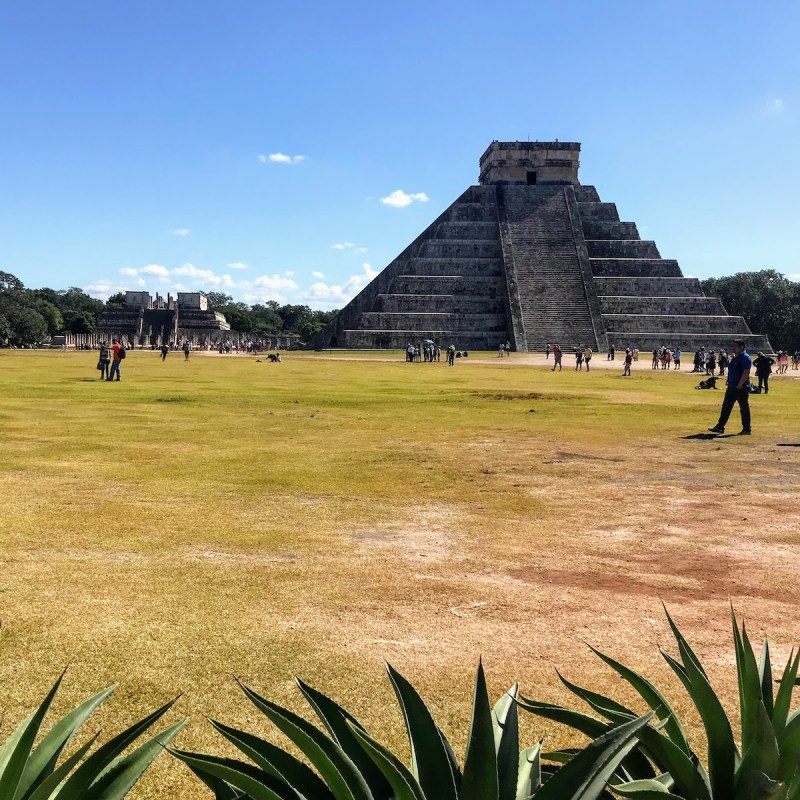
Known for its white-sand beaches, dense tropical jungle, crystal-clear cenotes (natural wells), ancient Maya ruins, and colonial cities, Mexico’s Yucatan Peninsula is the most spectacular region of the country. Referred to as the Yucatan, the peninsula comprises three states of Mexico: Yucatan state, Quintana Roo, and Campeche. Home to the famous Riviera Maya, the coast and the rest of the peninsula is the most visited area of Mexico. This means that except in the most remote villages, you’ll find someone who understands and speaks at least some English. But, while you will be perfectly alright speaking English in the more visited areas of the Yucatan, understanding — and speaking a bit of the local language helps make your visit more enjoyable.
Videos by TravelAwaits
The following are a few of the phrases that can make your communication with locals in the Yucatan easier.

1. ¿Habla Inglés?
Do You Speak English?
This is probably going to be the most important phrase you will use in the Yucatan if you don’t speak Spanish. In the more visited areas, like Cancún, Tulum, Puerto Morelos, Playa del Carmen, and the most visited Maya archaeological sites, most people will say yes, so you can communicate with them in English. However, if you venture off the beaten path, you might find yourself in villages or at out-of-the-way cenotes where they may shake their heads no.
2. Hablo Un Poco De Español/Hablo Muy Poco Español
I Speak A Little Spanish.
You should use this phrase when you try to communicate with someone who doesn’t speak English. Sometimes, they may answer with the same phrase. That’s because they are Maya, and Spanish is a second language for them, too. Which, in my experience, makes communication easier. Not because you have more words to play with, but a few words can express a lot, accompanied by gestures. In this case, you may both feel free to use as many gestures as possible, and try different Spanish — and English words to express yourself. I found these communications a lot of fun, especially if we tried learning Mayan words.
3. No Comprendo.
I Don’t Understand.
This is an important phrase to tell people that you don’t understand what they are saying. Sometimes, they may repeat it using a different word, or they may just use gestures to explain what they are talking about.
However, if you have a dictionary or any language app on your phone, you can ask them to type it in and it will translate for you. You could use it the other way, too. If you are trying to say something and you don’t know how, type it in English, and show them the translation.
However, be aware that no matter how good the translation app is, it might translate it wrong. You’ll know it if locals you try to communicate with look at you as if it doesn’t make sense, or start laughing. It is often just a grammatical error, and it might take them a little time to understand, then they will tell you the phrase the way they use it. Have them type it in Spanish, and translate it back, to see if they understood it right. If it looks like something you definitely didn’t want to say, try again using different English words or typing the individual words. Yucatecans are extremely patient and don’t mind waiting to figure out what they were missing. Actually, I found that they enjoy these types of interactions, and it adds an extra element to the interaction, of solving a puzzle together.

4. Como Se Dice … En Español/En Maya?
How Do You Say … In Spanish/In Mayan?
You can use this phrase if you want to learn a word in Spanish (or Mayan, when you know you are interacting with an indigenous Maya person) while pointing at something you want to know the name of. If they know some English, you can use the English word.
For example, I learned the word for bat (zotz) in Mayan, not in Spanish, because we went into a cave with a local Maya guide, and when we saw bats, asked him what they call them in Maya. He was happy we cared. Of course, we knew for sure he was Maya. He told us he was Maya, then laughed with us about us speaking only “poquito Español.”
5. Yo Soy … (Add Your Name).
I Am (Add Your Name).
People of the Yucatan are very friendly and like to get personal when dealing with you. So, they like to introduce themselves, and they expect the same. This is especially true if you hire a guide to take you to a little-known ruin or cenote.
6. Mucho Gusto.
Glad To Meet You.
It is always polite to use this phrase after someone introduces themselves to you. Interactions become more personal this way.
7. Hola; Buenos Días; Buenas Tardes
Hello; Good Morning; Good Afternoon
All three phrases are used as a greeting during the day. While hola is used any time, buenos días is only used in the morning (even though it means good day), while buenas tardes is used in the afternoon.
In smaller towns, it is still customary in Yucatan to greet everyone you meet in the street. While you may hear hola, especially from the younger generation, more often it is followed by buenos días or buenas tardes. It is more polite to use the full greeting.
If you spend more time in the same town, people will recognize you and may correct you if you use the wrong phrase. When I first used to travel to the Yucatan, I knew little Spanish, so I used only hola. When most people answered “Hola, buenos días,” I learned to use the full greeting. However, for a long time I assumed that, since día means day, it was ok to use it all day. Until one day, when a group of women in Cobá corrected me, answering, “buenas tardes.” I’ve heard others answer me with that phrase, but didn’t know what it meant, so I never used it before. This time, one of the women smiled, and showed me the time on her watch. After 12 p.m., she explained, it’s “tardes.”

8. ¿Cómo Estás? Or ¿Cómo Está Usted?
How Are You? (Informal And Formal Forms)
Spanish has two different forms for “you”, one used with friends, close acquaintances, and children, and another, formal one, most often used with strangers, older people, and anyone we want to express respect to. The informal form of “you” is tú and the formal form of “you” is usted.
9. Bien, ¿Y Tú? Or Muy Bien, ¿Y Usted?
I’m Good, And You? (Informal And Formal Forms)
This is the answer to the above question, both in the informal and formal form. It is always polite in the Yucatan to ask the same question in return. The answer after that may be, “todo bien” meaning, “everything is good.”
10. Por Favor
Please
When you are buying something in the Yucatan, even if you don’t know the object’s name, you can point to it, and say please. They will understand. Besides that, this is one of those basic words we should use every day, especially in a foreign country.
11. Gracias; Muchas Gracias
Thank You; Thank You Very Much
Of course, this is another one of the basic words to know in any language. In the Yucatan, you’ll hear it — and should use it — a lot.
12. De Nada
You Are Welcome
The true translation for this phrase is “for nothing.” It is just a way to express that it is not a problem. Although, most often locals go out of their way to help you, then they still tell you it was nothing.

13. ¿Cuánto Cuesta?
How Much Does It Cost?
This is a phrase you will use often if you buy anything in the Yucatan outside of the large tourist shops. Local vendors will write the number on their palms after they tell you and realize you didn’t understand, so it’s ok if you don’t know the numbers.
14. ¿Dónde Está … ?
Where Is … ?
You might need to use this phrase often, followed by the word for whatever you are looking for. For example, I often used “¿dónde esta el baño?” This means, “where is the restroom?” I used this phrase when eating in a local restaurant where the signs may not be visible.
We also used ¿Dónde está un vulcanizador? This means, where can I find a tire repair shop? We asked this while driving through the peninsula and had a flat tire.
Final Thoughts
Communicating in the Yucatan Peninsula is easy, regardless of how much you understand or speak Spanish (or Mayan), though people in small villages off the main tourist track don’t speak English. When all else fails, smiles and gestures, combined with a few words in Spanish, can make communication possible with locals anywhere in the Yucatan.
Understanding a few words and phrases always helps, though. Make sure you have a translation app on your phone to help you, even if you know some Spanish.
For more information on traveling to Mexico, check out these articles:
